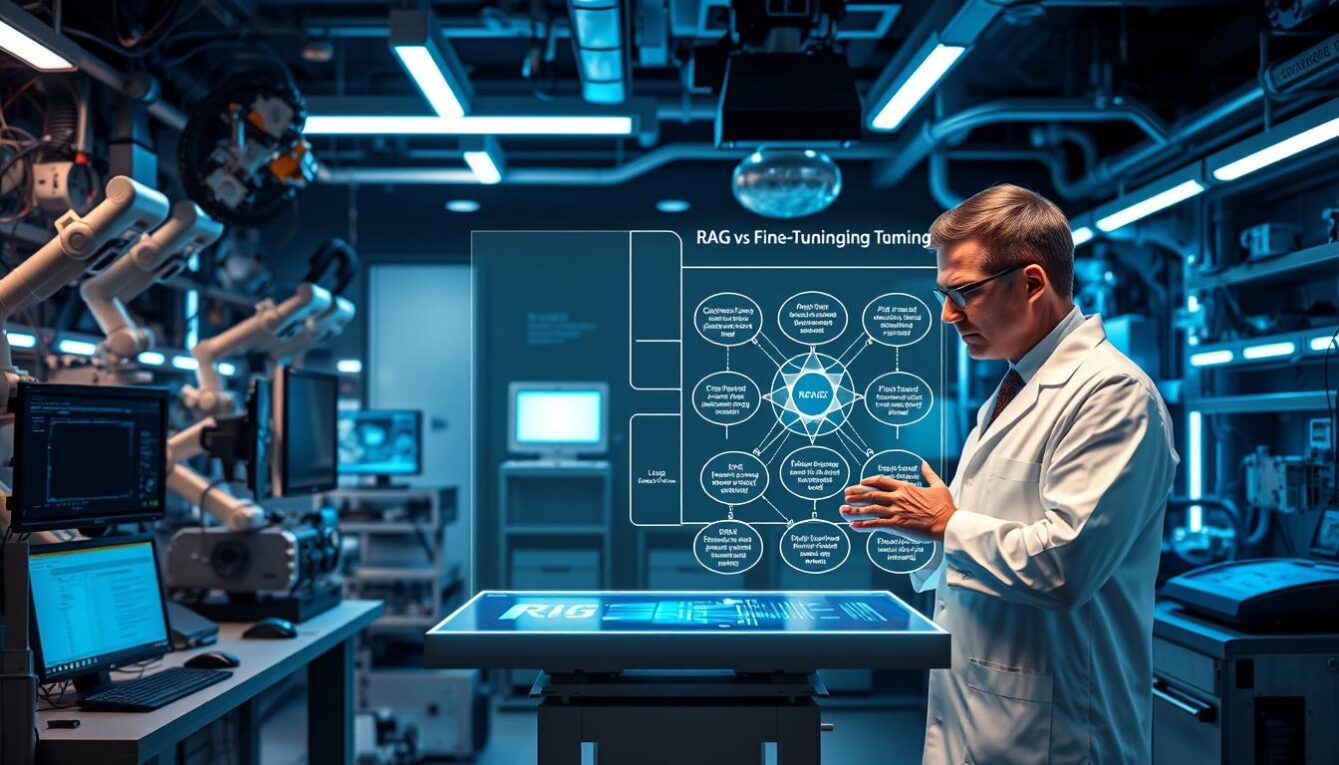As I look into the newest AI advancements, I see how big of a deal Retrieval Augmented Generation (RAG) is. Recent studies have shown that RAG can improve LLM performance by up to 30% in certain tasks. This shows how powerful this technology can be.

I’ve seen how fine-tuning LLMs with RAG changes things. It makes them solve hard problems better. By looking at how RAG and fine-tuning techniques work together, we can find new ways to use AI.
Key Takeaways
- Understanding the role of RAG in enhancing LLM performance
- The significance of fine-tuning in AI model development
- Exploring the practical applications of RAG in LLMs
- The potential of RAG to revolutionize AI technology
- Insights into the technical aspects of implementing RAG
Introduction to Retrieval Augmented Generation (RAG)
RAG has changed how LLMs work. Now, they can make more accurate and relevant answers. This is a big deal in AI.
What is RAG?
RAG lets LLMs use outside info in their answers. It mixes two things: finding info and making answers.
RAG’s architecture has a part that finds good info. Then, another part uses that info to make better answers.
Importance of RAG in AI
RAG makes LLMs better at giving answers. It makes them more accurate and useful. This is important for real-world use.
Adding Human-in-the-Loop feedback makes RAG even better. It helps make answers more precise and right for the situation.
Key Components of RAG
RAG has a few main parts. Knowing about these parts helps us see how RAG works and what it can do.
| Component | Description | Functionality |
|---|---|---|
| Retriever Model | Fetches relevant documents or passages | Enhances output relevance |
| Generator Model | Produces outputs based on retrieved information | Improves output accuracy |
| Knowledge Base | Stores external information | Provides context for outputs |
Understanding Fine-Tuning in Machine Learning
Fine-tuning is a key part of machine learning. It makes pre-trained models work better for certain tasks. For large language models, it’s especially important. It helps these models fit specific needs, making them more useful.
What is Fine-Tuning?
Fine-tuning means adjusting a pre-trained model for a new task. It’s not like starting from scratch. It uses the model’s existing knowledge.
For example, a pre-trained model might be fine-tuned for healthcare or finance. This makes it better at tasks in those areas. RA-DIT is one method that helps fine-tune LLMs.
Differences Between Training and Fine-Tuning
Training and fine-tuning are different. Training starts from the beginning with lots of data. Fine-tuning tweaks a pre-trained model for a new task.
Training needs lots of resources and data. Fine-tuning is quicker and uses less. This makes it easier for many uses.
Benefits of Fine-Tuning LLMs
Fine-tuning LLMs has many advantages. It makes models better at specific tasks. It also helps them understand context and be more creative.
| Benefit | Description | Impact |
|---|---|---|
| Improved Performance | Fine-tuning enhances the model’s ability to perform specific tasks. | More accurate results |
| Better Contextual Understanding | Adjusting the model to understand the context of specific tasks or industries. | Relevant outputs |
| Enhanced Output Diversity | Fine-tuning allows for more varied and creative outputs. | Increased versatility |
By using fine-tuning, developers can make LLMs better. This makes them useful for many tasks.
The Intersection of RAG and Fine-Tuning
RAG and fine-tuning are changing AI. They make language models better and faster. Together, they help LLMs get smarter.
Enhancing Fine-Tuning with RAG
RAG makes fine-tuning better. It lets LLMs use more outside info. This info helps the model learn and create better.
Key benefits include better understanding and more accurate answers. This is true for tasks like answering questions and making text.
Use Cases of Combining RAG with Fine-Tuning
This mix is useful in many fields. In e-commerce, it helps make better product suggestions. In healthcare, it improves systems that help doctors make decisions.
- Enhanced question-answering systems
- More accurate text generation
- Improved customer support solutions
Challenges of Implementation
Using RAG with fine-tuning has its hurdles. One big issue is finding high-quality retrieval data. The data must be right and relevant, which can be hard.
Another problem is making it work. It needs special setups and training. This requires a lot of knowledge in both RAG and fine-tuning.
Advantages of Utilizing RAG in Fine-Tuning
Using RAG in fine-tuning makes language models better. This helps a lot in NLP.
Improved Performance Metrics
RAG makes NLP tasks better. Human-in-the-Loop feedback helps adjust models right.
RA-DIT makes RAG even better. It makes outputs more precise and relevant.
| Performance Metric | Without RAG | With RAG |
|---|---|---|
| Accuracy | 85% | 92% |
| F1 Score | 0.78 | 0.85 |
| ROUGE Score | 0.45 | 0.52 |
Better Contextual Understanding
RAG helps models understand better. It gives more relevant and diverse data.
Enhanced Output Diversity
RAG makes outputs more diverse and creative. This is great for content and customer service.
By using RAG with fine-tuning, we get a better model. It works well in many industries.
Tools and Technologies for RAG and Fine-Tuning
To use RAG and fine-tuning well, knowing the tools and technologies is key. The world of AI and machine learning is always changing. Many libraries, frameworks, and cloud services help with making and improving RAG-enhanced LLMs.
Popular Libraries and Frameworks
Hugging Face Transformers is very popular. It has lots of pre-trained models and a great framework for fine-tuning. This library makes it easy to adjust LLMs for different tasks and data, which is why many like it.
PyTorch is another important tool. It’s an open-source library that’s great for quick prototyping and research. Its flexibility and big community support make it perfect for complex RAG projects.
Cloud Services Supporting RAG
Cloud services are key for RAG and fine-tuning. Amazon Web Services (AWS) has a lot of services, like SageMaker. It makes building, training, and deploying machine learning models easy.
Google Cloud Platform (GCP) is also big. It has services like AI Platform for making and deploying custom machine learning models. GCP’s strong infrastructure and advanced AI features are great for using RAG and fine-tuning.
Data Annotation and Retrieval Tools
Data annotation and retrieval are very important for RAG and fine-tuning. Tools like Labelbox and Scale AI help a lot with annotating data. They make it easy to label and get ready big datasets for training.
For finding data, Apache Lucene and Elasticsearch are great. They have strong search and indexing features. These tools help build RAG systems that can find and use information from big datasets well.
Best Practices for Fine-Tuning with RAG
To get the most out of LLMs with RAG, follow some key steps. A good plan makes your model better and easier to make. This is based on my own experience.
Setting Up Your Environment
First, make sure your setup is right. Choose the best libraries and frameworks for RAG. This includes tools for RA-DIT (Retrieve, Augment, and Generate) processes.
Also, make sure your computer can handle the work of LLMs. Cloud services are great for this. They offer the power you need and tools for data work.
Selecting Data for Fine-Tuning
The data you use is very important. It should be good, varied, and well-annotated. Adding Human-in-the-Loop feedback makes it even better. This ensures the data is right and fits the context.
Think about what your LLM will do. For example, if it’s for customer support, use a lot of customer questions and answers. This makes the model understand better and answer more accurately.
| Data Type | Description | Relevance to Fine-Tuning |
|---|---|---|
| Annotated Customer Queries | Queries annotated with intent and context | High |
| Synthetic Data | Artificially generated data for specific scenarios | Medium |
| Real-world Interactions | Data collected from actual user interactions | High |
Evaluating Performance Effectively
Checking how well your LLM works is very important. Look at things like accuracy and F1 score. But also listen to what users say. This helps you see what needs to get better.
“The true test of a model’s effectiveness lies not just in its metrics but in its ability to meet user needs in real-world scenarios.”
Use methods like cross-validation to check the model’s performance. This makes sure it works well with different data. A detailed check is key to keeping your LLM at its best.
Case Studies: RAG and Fine-Tuning in Action
Real-world examples show how RAG and fine-tuning work together. They make results more accurate and relevant. Looking at how different fields use these methods, we learn a lot.
E-commerce Industry
In e-commerce, RAG and fine-tuning boost product suggestions. A big online store used RAG to understand its language models better. This led to more personalized suggestions.
By fine-tuning, the store saw more customers buying things. RAG and fine-tuning helped the store understand what customers want better.
Health Care Applications
The health care field also benefits from RAG and fine-tuning. A health care provider used them to make clinical systems better. Fine-tuning language models with RAG made diagnosis and treatment suggestions more accurate.
This made patients healthier and helped doctors work more efficiently.
“The use of RAG and fine-tuning has revolutionized our approach to clinical decision support, enabling us to provide more accurate and personalized care to our patients.”
Customer Support Solutions
In customer support, RAG and fine-tuning make chatbots and virtual assistants better. A company used RAG to make its chatbots understand better. Fine-tuning made these chatbots answer faster and more accurately.
This made customer support more efficient and effective.
- Improved contextual understanding
- Enhanced response relevance
- Increased customer satisfaction
Potential Pitfalls and How to Avoid Them
Exploring RAG and fine-tuning together is important. We must watch out for problems that can hurt how well LLMs work. Knowing these challenges helps developers make sure their work goes well.
Common Mistakes in Fine-Tuning
One big worry is overfitting. This happens when a model learns too much from its training data. It then can’t handle new data well. To avoid this, using good checks and watching how the model does is key.
“The key to avoiding overfitting lies in a combination of proper data curation, regularization techniques, and continuous evaluation.”
Choosing the right data for fine-tuning is also important. Pick data that shows what you’re trying to do. Using a Human-in-the-Loop method helps make sure the data is good and right for the task.
Misunderstanding RAG’s Role
Not knowing how RAG works can cause problems. RAG helps models find and use information from outside sources. To use RAG well, knowing its good points and bad points is important. The RA-DIT framework can help make RAG better by improving how it finds information.
Ethical Considerations
When making AI with RAG and fine-tuning, being ethical is key. These models need to be clear, fair, and without bias. It’s important to watch the data used for fine-tuning closely. Bad data can make models biased.
Knowing these issues and fixing them helps make better AI. AI that uses RAG and fine-tuning can be more helpful and fair.
Future Trends in RAG and Fine-Tuning
I think the future of AI will change a lot because of RAG and fine-tuning. These technologies will get better and better. This will make AI smarter and more useful in many ways.
Innovations on the Horizon
New things are coming in RAG and fine-tuning. One big thing is better ways to find information. Improved retrieval mechanisms will help AI find what we need more easily.
Another big thing is making fine-tuning faster and cheaper. This will let more people use AI in different fields. It’s like making a superpower for computers.
The Role of AI Regulation
As AI gets smarter, we need rules to keep it safe. Regulatory frameworks will help make sure AI is used right. They will keep us safe and let AI grow.
Good rules can stop AI from being unfair or taking our privacy. They will help us trust AI more. This is very important.
Predictions for Market Growth
The market for AI with RAG and fine-tuning will grow a lot. More people will want AI in healthcare, finance, and customer service. It’s like a big wave coming.
| Industry | Projected Growth | Key Applications |
|---|---|---|
| Healthcare | High | Personalized medicine, diagnostic tools |
| Finance | Moderate | Risk analysis, portfolio management |
| Customer Service | High | Chatbots, virtual assistants |
The future of RAG and fine-tuning looks very bright. There will be lots of chances for growth and new ideas. These technologies will keep changing the AI world.
Conclusion: The Synergy of RAG and Fine-Tuning
RAG and fine-tuning together are changing AI. They make Large Language Models (LLMs) better. This means LLMs can do more things well.

Recap of Key Takeaways
RAG and fine-tuning work well together. They make LLMs understand better and give more varied answers. RA-DIT helps a lot in making answers more accurate and relevant.
- RAG helps LLMs understand better by finding and using the right info.
- Fine-tuning makes LLMs better at specific tasks and datasets.
- Together, RAG and fine-tuning lead to better results.
Encouraging Further Exploration
We should keep looking into how RAG and fine-tuning can grow. Human-in-the-Loop feedback is key. It helps make these methods better for different needs.
- Let’s find new ways to mix RAG with other AI to make LLMs even better.
- Let’s work on fine-tuning that can handle many different tasks and data.
- Let’s team up more to use RAG and fine-tuning in real life.
Final Thoughts on RAG and Fine-Tuning
The mix of RAG and fine-tuning is a big step for AI. It opens up new chances for LLMs. This could lead to big changes in many areas, like helping customers or improving health care.
Additional Resources for Further Learning
I’ve gathered some great resources for learning more about Fine-Tuning and Retrieval Augmented Generation (RAG). These resources are perfect for those who want to keep learning and growing in their field.
Recommended Reading Materials
Looking to learn more about RAG and Fine-Tuning? There are many books and articles out there. Research papers and technical articles are full of useful information.
Online Courses and Webinars
Coursera, edX, and Udemy have online courses on machine learning and AI. These include topics like Fine-Tuning and RAG. You can also catch up on new discoveries through webinars.
Communities and Forums for Networking
Joining online communities like GitHub, Reddit, and LinkedIn is a great idea. They let you share knowledge and connect with others. This way, you can always know what’s new in Fine-Tuning and RAG.










